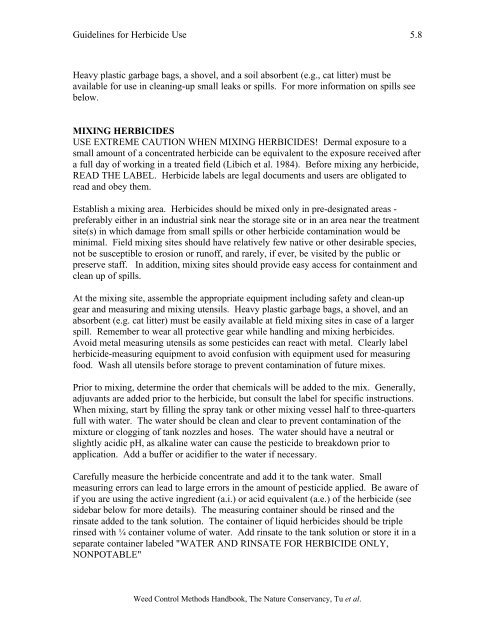Weed Control Methods Handbook: Tools ... - Invasive.org
Weed Control Methods Handbook: Tools ... - Invasive.org
Weed Control Methods Handbook: Tools ... - Invasive.org
You also want an ePaper? Increase the reach of your titles
YUMPU automatically turns print PDFs into web optimized ePapers that Google loves.
Guidelines for Herbicide Use 5.8<br />
Heavy plastic garbage bags, a shovel, and a soil absorbent (e.g., cat litter) must be<br />
available for use in cleaning-up small leaks or spills. For more information on spills see<br />
below.<br />
MIXING HERBICIDES<br />
USE EXTREME CAUTION WHEN MIXING HERBICIDES! Dermal exposure to a<br />
small amount of a concentrated herbicide can be equivalent to the exposure received after<br />
a full day of working in a treated field (Libich et al. 1984). Before mixing any herbicide,<br />
READ THE LABEL. Herbicide labels are legal documents and users are obligated to<br />
read and obey them.<br />
Establish a mixing area. Herbicides should be mixed only in pre-designated areas -<br />
preferably either in an industrial sink near the storage site or in an area near the treatment<br />
site(s) in which damage from small spills or other herbicide contamination would be<br />
minimal. Field mixing sites should have relatively few native or other desirable species,<br />
not be susceptible to erosion or runoff, and rarely, if ever, be visited by the public or<br />
preserve staff. In addition, mixing sites should provide easy access for containment and<br />
clean up of spills.<br />
At the mixing site, assemble the appropriate equipment including safety and clean-up<br />
gear and measuring and mixing utensils. Heavy plastic garbage bags, a shovel, and an<br />
absorbent (e.g. cat litter) must be easily available at field mixing sites in case of a larger<br />
spill. Remember to wear all protective gear while handling and mixing herbicides.<br />
Avoid metal measuring utensils as some pesticides can react with metal. Clearly label<br />
herbicide-measuring equipment to avoid confusion with equipment used for measuring<br />
food. Wash all utensils before storage to prevent contamination of future mixes.<br />
Prior to mixing, determine the order that chemicals will be added to the mix. Generally,<br />
adjuvants are added prior to the herbicide, but consult the label for specific instructions.<br />
When mixing, start by filling the spray tank or other mixing vessel half to three-quarters<br />
full with water. The water should be clean and clear to prevent contamination of the<br />
mixture or clogging of tank nozzles and hoses. The water should have a neutral or<br />
slightly acidic pH, as alkaline water can cause the pesticide to breakdown prior to<br />
application. Add a buffer or acidifier to the water if necessary.<br />
Carefully measure the herbicide concentrate and add it to the tank water. Small<br />
measuring errors can lead to large errors in the amount of pesticide applied. Be aware of<br />
if you are using the active ingredient (a.i.) or acid equivalent (a.e.) of the herbicide (see<br />
sidebar below for more details). The measuring container should be rinsed and the<br />
rinsate added to the tank solution. The container of liquid herbicides should be triple<br />
rinsed with ¼ container volume of water. Add rinsate to the tank solution or store it in a<br />
separate container labeled "WATER AND RINSATE FOR HERBICIDE ONLY,<br />
NONPOTABLE"<br />
<strong>Weed</strong> <strong>Control</strong> <strong>Methods</strong> <strong>Handbook</strong>, The Nature Conservancy, Tu et al.
















